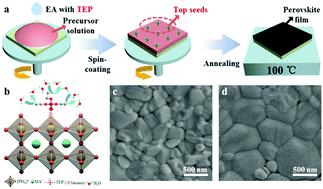当前位置:
X-MOL 学术
›
Mater. Chem. Front.
›
论文详情
Our official English website, www.x-mol.net, welcomes your
feedback! (Note: you will need to create a separate account there.)
Triethyl phosphate in an antisolvent: a novel approach to fabricate high-efficiency and stable perovskite solar cells under ambient air conditions
Materials Chemistry Frontiers ( IF 6.0 ) Pub Date : 2021-08-23 , DOI: 10.1039/d1qm00680k Pengyun Zhang 1 , Ningxia Gu 1 , Xiang Chen 1 , Lixin Song 1 , Pingfan Du 1 , Wei-Hsiang Chen 2 , Jie Xiong 1
Materials Chemistry Frontiers ( IF 6.0 ) Pub Date : 2021-08-23 , DOI: 10.1039/d1qm00680k Pengyun Zhang 1 , Ningxia Gu 1 , Xiang Chen 1 , Lixin Song 1 , Pingfan Du 1 , Wei-Hsiang Chen 2 , Jie Xiong 1
Affiliation

|
Organometallic halide perovskite solar cells (PSCs) with a high power conversion efficiency (PCE) have attracted immense attention for applications and commercialization. Nevertheless, it is still a challenge to find a novel method to overcome the rapid degradation of the perovskite so that PSCs demonstrating an excellent performance can be fabricated in an ambient environment without a glove box. Herein, in this paper, triethyl phosphate (TEP) is introduced into the perovskite layer via antisolvent engineering to serve as a crystallization aid and a humidity stabilizer. Impressively, the electron-rich phosphate group in TEP can form a strong chemical bonding interaction with the perovskite (Pb–O) to passivate the defects produced during crystallization. More interestingly, the ethyl group with its hydrophobic effect can protect the perovskite film from corrosion by the moisture in the air. As a result, the TEP-modified perovskite film demonstrates a dense and defectless morphology with a large grain size (a maximum of more than 1 μm). The TEP-treated device achieves a dramatic efficiency of 19.6% and negligible hysteresis of the photocurrent. Moreover, the humidity resistance of the TEP-modified device is significantly enhanced. The normalized PCE of the TEP-modified device (unencapsulated) can still retain 82% of its initial value after being stored in an 85% humidity environment under dark conditions for 400 hours. This finding provides a promising approach for facilitating the commercialization of PSCs.
中文翻译:

反溶剂中的磷酸三乙酯:一种在环境空气条件下制造高效稳定钙钛矿太阳能电池的新方法
具有高功率转换效率(PCE)的有机金属卤化物钙钛矿太阳能电池(PSC)在应用和商业化方面引起了极大的关注。尽管如此,找到一种新方法来克服钙钛矿快速降解的问题仍然是一个挑战,以便可以在没有手套箱的环境中制造出表现出优异性能的 PSC。这里,在本文中,磷酸三乙酯(TEP)被引入到钙钛矿层通过抗溶剂工程作为结晶助剂和湿度稳定剂。令人印象深刻的是,TEP 中的富电子磷酸基团可以与钙钛矿 (Pb-O) 形成强化学键相互作用,从而钝化结晶过程中产生的缺陷。更有趣的是,具有疏水作用的乙基可以保护钙钛矿薄膜免受空气中水分的腐蚀。结果,TEP 改性的钙钛矿薄膜表现出致密且无缺陷的形态,具有大晶粒尺寸(最大超过 1 μm)。经过 TEP 处理的器件实现了 19.6% 的惊人效率,并且光电流的滞后可以忽略不计。此外,TEP 改性器件的耐湿性显着增强。TEP改性器件(未封装)的归一化PCE在85%的湿度环境下避光保存400小时后,仍能保持其初始值的82%。这一发现为促进 PSC 的商业化提供了一种有前景的方法。
更新日期:2021-09-15
中文翻译:

反溶剂中的磷酸三乙酯:一种在环境空气条件下制造高效稳定钙钛矿太阳能电池的新方法
具有高功率转换效率(PCE)的有机金属卤化物钙钛矿太阳能电池(PSC)在应用和商业化方面引起了极大的关注。尽管如此,找到一种新方法来克服钙钛矿快速降解的问题仍然是一个挑战,以便可以在没有手套箱的环境中制造出表现出优异性能的 PSC。这里,在本文中,磷酸三乙酯(TEP)被引入到钙钛矿层通过抗溶剂工程作为结晶助剂和湿度稳定剂。令人印象深刻的是,TEP 中的富电子磷酸基团可以与钙钛矿 (Pb-O) 形成强化学键相互作用,从而钝化结晶过程中产生的缺陷。更有趣的是,具有疏水作用的乙基可以保护钙钛矿薄膜免受空气中水分的腐蚀。结果,TEP 改性的钙钛矿薄膜表现出致密且无缺陷的形态,具有大晶粒尺寸(最大超过 1 μm)。经过 TEP 处理的器件实现了 19.6% 的惊人效率,并且光电流的滞后可以忽略不计。此外,TEP 改性器件的耐湿性显着增强。TEP改性器件(未封装)的归一化PCE在85%的湿度环境下避光保存400小时后,仍能保持其初始值的82%。这一发现为促进 PSC 的商业化提供了一种有前景的方法。











































 京公网安备 11010802027423号
京公网安备 11010802027423号